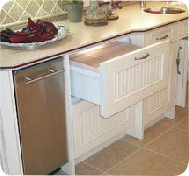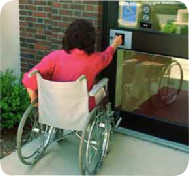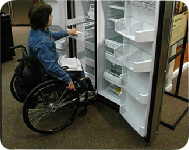



Visitability is an international movement to change home construction practices so that virtually all new homes, whether or not designated for residents who currently have mobility impairments, offer three specific accessibility features. Supporters ultimately want to require that all new homes be at least partly accessible to people with mobility impairments.
Newly constructed homes often contain the same major barriers as older, existing homes: steps at every entrance, and narrow interior doors, with the bathroom door usually the narrowest door in the house. Therefore, in the visitability movement, three key features are promoted:
1. At least one zero-
2. All interior doors providing at least 31 ¾ inches (81 cm) of unobstructed passage space and
3. At least a half bathroom on the main floor
If a goal is residents' remaining in the home if mobility impairment occurs, two additional basics are necessary: a full bathroom on the main floor, and a bedroom or space that could be converted to a bedroom.
Visitability is similar to Universal Design in general intention, but is more focused in scope, more specific in parameters, and more explicitly grounded in a social reform intent.
Visitability features make homes easier for people who develop a mobility impairment to visit friends and extended family rather than having to turn down invitations, or not be invited at all. These features also provide a basic shell of access to permit formerly non-
Specific goals
1. A focus on single-
2. Every home instead of just "special" homes. Being able to attend the party is better than isolation, or the risk of being "helped up the steps." People who use wheelchairs or walkers, or are impaired by stiffness, weakness or balance problems are blocked by steps at every entrance of a home. Wheelchair users are stopped by inches from fitting through the bathroom door in a friend or relative’s home.
3. Narrowing the emphasis to the most essential features, which are:
· entering a home,
· fitting through the interior doors, and
· being able to use a toilet.
While there are many possible or desirable features, strongly prioritizing the few features which are most crucial to visiting or residing in a home greatly increases the likelihood of widespread construction change.
Basic access goes beyond visiting. It also helps a person of any age who develops a temporary or permanent mobility impairment. Without basic access in place, architecture forces severe choices:
· Expensive renovations, assuming that the necessary changes are possible.
· Being unable to enter or exit the home independently, or to use the bathroom at all.
· Moving to another home or to a nursing home or other specialized facility.
These issues can apply equally to a person who is recovering from surgery, or to a person who has used a wheelchair for decades.
Construction issues
Zero-
On new construction, a zero-
For the 40% of homes built with a slab-
History
In the United States, the Visitability movement was begun by grass roots advocates led by Eleanor Smith in an organization called Concrete Change, who originated and developed the concept in 1986, at that time using the term "Basic Home Access". In 1990, when US advocates learned that the term “Visitability” was used in Great Britain for a similar concept, they adopted the term to emphasize that the goal is not the traditional “more homes for the disabled” but rather a change in standard homebuilding procedure. Concrete Change continues to grow in number of participants and number of open-
Great Britain applies the most widespread application of the concept to date. In 1999, Parliament passed "section M", an amendment to residential building regulations requiring basic access in all new homes.
Advocates maintain that the philosophical underpinning of Visitability is as important as the list of features. They maintain that building homes with steps at all entrances and narrow interior doors is an unacceptable violation of human rights, given the harsh effects the barriers have on so many people's lives: physically unsafe living conditions, social isolation and forced institutionalization.
Benefits
· Residents in the community can welcome guests who use wheelchairs or walkers (walking frames), or have some other mobility impairment such as stiffness, weakness or poor balance. When Visitability is in place, mobility-
· If a family member develops a disability though illness, accident or aging, the person and their family are more likely to be able to remain in their existing home, rather than having to do major, expensive renovation—or move to another house, or a nursing home.
· All residents find it easier to bring in baby strollers, grocery carts, or heavy furniture.
· Visitable homes enhance sale and re-
· Visitability features cost little up front -
· Besides human rights, advocates cite the economic implications of Visitability. By 2010, research by the National Association of Home Builders indicates that half of all US homes will be headed by persons 55 years old or older. Average nursing home costs exceed $60,000 dollars per year per resident, while nearly 70% of nursing home costs are paid with public funds. Staying out of institutions as long as possible is a strong desire of most people and also financially beneficial to individuals, families and society.
Adoption of visitability laws
Because not all locations use the term “visitability” in their efforts, it is difficult to definitively track the adoption of visitability across the country. Other factors complicating the research include the lack of an organization assigned to monitor visitability ordinances, and ordinances and laws that often do not specify the agency responsible for implementation.
In the United States, successful Visitability legislation has been passed in many localities, including Atlanta, Georgia; Pima County, Arizona; Bolingbrook, Illinois; San Antonio, Texas; and the State of California. As of June 2006, 46 state and local municipalities had a confirmed visitability program in place; while 25 of these programs are mandatory ordinances, the other 21 are voluntary initiatives (i.e. cash and tax incentives for builders and consumers, consumer awareness campaigns, and certification programs). In addition, there are numerous efforts to establish visitability programs in other states, counties and cities across the country. The research identified another 30 initiatives currently underway. They range from organized groups of individuals with an expressed interest in beginning a visitability program to locations that are in the final stages of developing a program.

Cabinetry designed with accessibility in mind.

A disabled person attempting to gain entry into a building.

Refrigerator design to meet the needs of a disabled person.

Kitchen designed with accessibility in mind.
